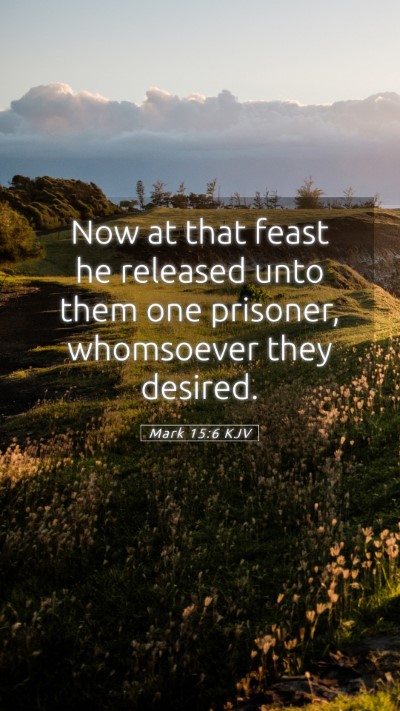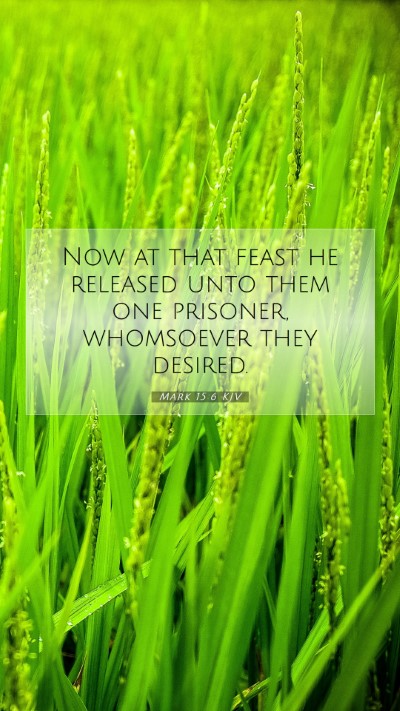Bible Verse Meaning: Mark 15:6
Mark 15:6 states: "Now at that feast he released unto them one prisoner, whomsoever they desired." This verse occurs during the events leading up to the trial and crucifixion of Jesus, illustrating the historical context of the Passover feast, where it was customary for the governor to release a prisoner of the people's choosing.
Overview and Context
This verse emphasizes the practice of releasing a prisoner during Passover, reflecting Jewish tradition and the relationship between the Jewish people and Roman authority. It sets the stage for the choice between Jesus and Barabbas, underscoring the tension surrounding Jesus’ trial.
Insights from Commentaries
-
Matthew Henry's Commentary
Matthew Henry notes that this custom of releasing a prisoner signifies the pardon and mercy that is often extended during significant religious observances. He highlights the irony present in the events that unfold, as the innocent Jesus is placed in direct contrast against Barabbas, a known criminal. This contrast emphasizes the rejection of righteousness and justice by the people.
-
Albert Barnes' Notes on the Bible
Albert Barnes explains the political implications behind this practice, suggesting that it served both to placate the Jewish populace and to strengthen the governor's political standing. The choice given to the people highlights their influence and the perilous nature of Jesus' situation, culminating in the subsequent decision to call for Jesus’ crucifixion.
-
Adam Clarke's Commentary
Adam Clarke goes into detail about the significance of the chosen prisoner, Barabbas, whose name means "son of the father." Clarke draws a parallel between Barabbas, a symbol of earthly rebellion, and Jesus, the true Son of God, who brings spiritual salvation. This contrast serves to deepen the understanding of the events leading to the crucifixion as a miscarriage of justice.
Key Themes and Analysis
The central theme of Mark 15:6 revolves around choice and consequence. The decision made by the crowd reflects the broader themes of sin, injustice, and the rejection of the Messiah. The public’s preference for Barabbas reveals a profound misunderstanding of justice and righteousness, which can be further examined in various biblical contexts.
Application to Daily Life
Understanding Mark 15:6 provides insight into human nature and the choices we make. Much like the crowd, individuals today face daily choices that reflect their values and beliefs. This passage serves as a reminder to reflect on the implications of our decisions and the influences that guide them.
Cross References
-
Matthew 27:15-26
This passage provides a parallel account of the events surrounding the release of Barabbas instead of Jesus.
-
John 18:39-40
John further emphasizes the choice between Jesus and Barabbas, providing additional details on the crowd's demand.
-
Luke 23:16-19
In this parallel account, the context of the decision is elaborated upon, illustrating the tension leading up to the crucifixion.
Conclusion
Mark 15:6 serves as a poignant narrative on the themes of choice, justice, and redemption. Through engaging with this verse and its commentaries, individuals can deepen their Bible verse understanding and enrich their Bible study insights. By recognizing the historical and spiritual implications, believers can translate these lessons into their own lives, understanding the gravity of their choices as they reflect on the significance of this verse.


